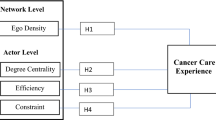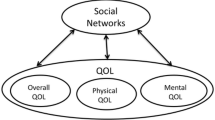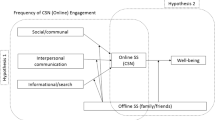Abstract
Purpose
Robust social networks are associated with improved health and quality of life for cancer survivors. Certain cancer diagnoses are associated with higher levels of stigma than breast cancer. However, little is known about the differences in social networks depending on the type of malignancy. This study aims to assess the differences in social networks and general health between breast cancer and more stigmatized cancers.
Methods
Cancer survivors were recruited to participate in a cross-sectional online survey study. Social network size and satisfaction was measured using the Cancer Survivor Social Networks Measure. General health was measured with a five-point-Likert-style item.
Results
The average age of the sample (n = 99) was 57.6 years old (SD = 13.4) and the majority were female (67.7%). Breast cancer survivors had an average of 1.39 more members in their social network than other cancers (t(94) = 2.28, p = 0.025). There were no significant differences between groups in network satisfaction. Results of a binary logistic regression model explained 26.9% of the variance in general health (x2(5) = 18.35, p = 0.003). There was a significant association among formal support network satisfaction (β = − 1.23, p = 0.021), formal support network size (β = − 0.36, p = 0.019), malignancy type (breast vs. other) (β = 1.05, p = 0.05), and better general health.
Conclusions
The results suggest breast cancer survivors had more formal social supports then other malignancy types. An association among greater formal social network size and satisfaction, a diagnosis of breast instead of other cancers, and better general health was noted. Emphasizing formal support sources for all cancer survivors may improve their overall health.
Similar content being viewed by others
References
Miller KD, Siegel RL, Lin CC, Mariotto AB, Kramer JL, Rowland JH, Stein KD, Alteri R, Jemal A (2016) Cancer treatment and survivorship statistics, 2016. CA Cancer J Clin 66:271–289. https://doi.org/10.3322/caac.21349
Lim J, Zebrack B (2006) Social networks and quality of life for long-term survivors of leukemia and lymphoma. Support Care Cancer 14:185–192. https://doi.org/10.1007/s00520-005-0856-x
Pinquart M, Duberstein PR (2010) Associations of social networks with cancer mortality: a meta-analysis. Crit Rev Oncol Hematol. https://doi.org/10.1016/j.critrevonc.2009.06.003
Kim BH, Wallington SF, Makambi KH, Adams-Campbell LL (2015) Social networks and physical activity behaviors among cancer survivors: data from the 2005 health information national trends survey. J Health Commun 20:656–662
Kroenke CH, Kubzansky LD, Schernhammer ES, Holmes MD, Kawachi I (2006) Social networks, social support, and survival after breast cancer diagnosis. J Clin Oncol 24:1105–1111. https://doi.org/10.1200/JCO.2005.04.2846
Flanagan J, Holmes S (2000) Social perceptions of cancer and their impacts: implications for nursing practice arising from the literature. J Adv Nurs 32:740–749. https://doi.org/10.1046/j.1365-2648.2000.01535.x
Fife BL, Wright ER (2000) The dimensionality of stigma: a comparison of its impact on the self of persons with HIV/AIDS and cancer. J Health Soc Behav 41:50–67
Koller M, Kussman J, Lorenz W, Jenkins M, Voss M, Arens E, Richter E, Rothmund M (1996) Symptom reporting in cancer patients: the role of negative affect and experienced social stigma. Cancer: Interdisciplinary International Journal of the American Cancer Society 77(5)983–995
LoConte NK, Else-Quest NM, Eickhoff J et al (2008) Assessment of guilt and shame in patients with non-small-cell lung cancer compared with patients with breast and prostate cancer. Clin Lung Cancer 9:171–178. https://doi.org/10.3816/CLC.2008.n.026
Chapple A, Ziebland S, McPherson A (2004) Stigma, shame, and blame experienced by patients with lung cancer: qualitative study. BMJ 328:1470. https://doi.org/10.1136/bmj.38111.639734.7C
Lebel S, Devins GM (2008) Stigma in cancer patients whose behavior may have contributed to their disease. Future Oncol 4(5):717–733
Jefferies H, Clifford C (2011) Aloneness: the lived experience of women with cancer of the vulva. Eur J Cancer Care (Engl). 20:738–746. https://doi.org/10.1111/j.1365-2354.2011.01246.x
Bullen K, Edwards S, Marke V, Matthews S (2010) Looking past the obvious: experiences of altered masculinity in penile cancer. Psychooncology 19:933–940. https://doi.org/10.1002/pon.1642
Philp S, Mellon A, Barnett C, D'Abrew N, White K (2017) The road less travelled: Australian women’s experiences with vulval cancer. Eur J Cancer Care (Engl) 26. https://doi.org/10.1111/ecc.12465
Knapp-Oliver S, Moyer A (2012) Causal attributions predict willingness to support the allocation of funding to lung cancer treatment programs. J Appl Soc Psychol 42:2368–2385. https://doi.org/10.1111/j.1559-1816.2012.00945.x
National Breast Cancer Foundation National Breast Cancer Foundation. https://www.nationalbreastcancer.org/breast-cancer-awareness-month. Accessed 1 June 2018
ResearchMatch. Version 2018. Vanderbilt University
Cancer Survivor Social Networks Measure | Cancer Surveillance and Outcomes Research Team. http://cansort.med.umich.edu/research/tools-and-resources/patient-survey-measures/cancer-survivor-social-networks-measure/. Accessed 28 Nov 2018
Qualtrics Labs, Inc [computer program]. Version June 2018. Provo, Utah, USA. 2009
IBM Corp. Released 2017. IBM SPSS statistics for Macintosh, version 25.0. IBM Corp, Armonk
Berkman LF (1995) The role of social relations in health promotion. Psychosom Med 57:245–254. https://doi.org/10.1097/00006842-199505000-00006
House JS, Landis KR, Umberson D (1988) Social relationships and health. Science 59:676–684. https://doi.org/10.1037/0003-066X.59.8.676
Uchino BN, Cacioppo JT, Kiecolt-Glaser JK (1996) The relationship between social support and physiological processes: a review with emphasis on underlying mechanisms and implications for health. Psychol Bull 119:488–531. https://doi.org/10.1037/0033-2909.119.3.488
Ell K, Nishimoto R, Mediansky L, Mantell J, Hamovitch M (1992) Social relations, social support and survival among patients with cancer. J Psychosom Res 36:531–541. https://doi.org/10.1016/0022-3999(92)90038-4
Spiegel D, Bloom JR, Kraemer HC, Gottheil E (1989) Effect of psychosocial treatment on survival of patients with metastatic breast cancer. Lancet. https://doi.org/10.1016/S0140-6736(89)91551-1
Kuchler T, Henne-Bruns D, Rappat S et al (1999) Impact of psychotherapeutic support on gastrointestinal cancer patients undergoing surgery: survival results of a trial. Hepatogastroenterology 46(25):322–335
Satariano WA, Haight TJ, Tager IB (2002) Living arrangements and participation in leisure-time physical activities in an older population. J Aging Health 14:427–451. https://doi.org/10.1177/089826402237177
Michael YL, Kawachi I, Berkman LF, Holmes MD, Colditz GA (2000) The persistent impact of breast carcinoma on functional health status: prospective evidence from the nurses’ health study. Cancer 89:2176–2186. https://doi.org/10.1002/1097-0142(20001201)89:11<2176::AID-CNCR5>3.0.CO;2-6
Ganz PA, Coscarelli Schagi CA, Cheng HL (1990) Assessing the quality of life-a study in newly-diagnosed breast cancer patients. J Clin Epidemiol 43:75–86. https://doi.org/10.1016/0895-4356(90)90059-X
Reynolds P, Kaplan G a (1990) Social connections and risk for cancer: prospective evidence from the Alameda County study. Behav Med 16:101–110. https://doi.org/10.1080/08964289.1990.9934597
Zhu K, Hunter S, Bernard LJ et al (2000) Mammography screening in single older African-American women: a study of related factors. Ethn Dis
Kang SH, Bloom JR (1993) Social support and cancer screening among older black Americans. J Natl Cancer Inst 85:737–742
Kang SH, Bloom JR, Romano PS (1994) Cancer screening among African-American women: their use of tests and social support. Am J Public Health 84:101–103. https://doi.org/10.2105/AJPH.84.1.101
Gravell J, Zapka JG, Mamon JA (1985) Impact of breast self-examination planned educational messages on social network communications: an exploratory study. Health Educ Behav 12:51–64. https://doi.org/10.1177/109019818501200105
Eng E (1993) The save our sisters project. A social network strategy for reaching rural black women. Cancer 72:1071–1077. https://doi.org/10.1002/1097-0142(19930801)72:3+<1071::AID-CNCR2820721322>3.0.CO;2-V
Bell K (2014) The breast-cancer-ization of cancer survivorship: implications for experiences of the disease. Soc Sci Med 110:56–63. https://doi.org/10.1016/j.socscimed.2014.03.031
Vaux A, Harrison D (1985) Support network characteristics associated with support satisfaction and perceived support. Am J Community Psychol 13:245–265. https://doi.org/10.1007/BF00914932
Sharf BF (1997) Communicating breast cancer on-line: support and empowerment on the Internet. Women Health 26:65–84. https://doi.org/10.1300/J013v26n01_05
Eakin EG, Strycker L a (2001) Awareness and barriers to use of cancer support and information resources by HMO patients with breast, prostate, or colon cancer: patient and provider perspectives. Psychooncology 10:103–113. https://doi.org/10.1002/pon.500
Guidry JJ, Aday LA, Zhang D, Winn RJ (1997) The role of informal and formal social support networks for patients with cancer. Cancer Pract
Langer SL, Brown JD, Syrjala KL (2009) Intrapersonal and interpersonal consequences of protective buffering among cancer patients and caregivers. Cancer 115:4311–4325. https://doi.org/10.1002/cncr.24586
Manne SL, Norton TR, Ostroff JS, Winkel G, Fox K, Grana G (2007) Protective buffering and psychological distress among couples coping with breast cancer: the moderating role of relationship satisfaction. J Fam Psychol 21:380–388. https://doi.org/10.1037/0893-3200.21.3.380
Decker CL (2007) Social support and adolescent cancer survivors: a review of the literature. Psychooncology 16:1–11
Hassan E (2005) Recall bias can be a threat to retrospective and prospective research designs. Internet J Epidemiol 3:1–11. https://doi.org/10.5580/2732
Author information
Authors and Affiliations
Corresponding author
Ethics declarations
Conflicts of interest
The authors declare that they have no conflicts of interest.
Additional information
Publisher’s Note
Springer Nature remains neutral with regard to jurisdictional claims in published maps and institutional affiliations.
Rights and permissions
About this article
Cite this article
Payne, N., Palmer Kelly, E. & Pawlik, T.M. Assessing structure and characteristics of social networks among cancer survivors: impact on general health. Support Care Cancer 27, 3045–3051 (2019). https://doi.org/10.1007/s00520-018-4620-4
Received:
Accepted:
Published:
Issue Date:
DOI: https://doi.org/10.1007/s00520-018-4620-4




